The Master Prompt Method: How I Use AI in Recruiting and Every Corner of My Business
I recently sat down with Hayden Miyamoto to explore something I’ve been thinking about for a long time: what happens when AI stops being a flashy assistant and becomes the actual operating system of a company. In our conversation we unpacked the Master Prompt Method — a practical, repeatable way to give AI full context so it becomes your smartest employee. In this article I’ll walk you through what Hayden teaches, show real-life demonstrations he used (including how we applied AI in recruiting), and give you a step-by-step framework so you can build your own master prompt version 1 for your organization.
Throughout this article I’ll summarize the ideas, quote key lines, and expand with practical advice to help you get started today.
Why this matters: AI as an operating system, not a novelty
Hayden and I both spend a lot of time with new technology. He told me he wakes up around 4:30 a.m. and spends the first five hours of his day experimenting with AI. That intensity isn’t about hype — it’s about opportunity. Hayden put it bluntly: "I firmly believe that AI can potentially double to triple every single one of my companies per year." That’s not a throwaway statement. It’s the calculation of an operator who runs three holding companies and roughly thirty active businesses across brick-and-mortar and digital portfolios.
What he’s seeing is that AI offers three concrete benefits when it’s given proper context:
- Speed: Tasks that took weeks can be done in hours.
- Quality: Output improves, sometimes dramatically.
- Scale & democratization: Small teams can execute processes that used to require large organizations.
Those three together are why AI becomes an operating system rather than a novelty. If your team can produce higher-quality work faster, and every person can leverage the same institutional knowledge through AI, your company fundamentally changes how it grows. That’s the heart of the Master Prompt Method.
What is the Master Prompt Method?
At its core, the Master Prompt Method is a simple idea: give AI as much detailed instruction and context as possible, once, and make that context persist so every interaction the AI has is informed by your company’s knowledge and values.
Hayden frames the problem like this: if you type a one-sentence prompt into a general chatbot with no context, you’ll often get an answer roughly equivalent to a Google search. That’s useful, but limited. The Master Prompt Method aims to turn that interaction into something more like an internal consultant who already understands your business, your people, your processes, and your strategy.
"How can I give full context for my business every single time I prompt without having to write anything?"
The practical answer is a single persistent document (or set of settings) that contains all the facts, frameworks, and protocols you want the AI to use. For Hayden, this became a 20–30 page living document that he stores in Claude's "personal preferences" and uses in combination with project-level knowledge for siloed contexts.
Three levels of prompting
Hayden described three levels of how people commonly interact with LLMs:
- Short one-off prompts — like a Google search.
- Copy-paste mega-prompts — long, specific instructions you paste each time.
- The Master Prompt — a persistent, shared source of truth that the AI references automatically.
The Master Prompt lives at the third level. It’s not about making prompts longer; it’s about making the AI smarter by default.
Tools and why Hayden prefers Claude/Anthropic for the Master Prompt
Several LLM platforms are evolving around memories, preferences, and project-level knowledge. Hayden described how Claude’s account preferences and project knowledge made it an ideal place for a master prompt because:
- You can store persistent personal preferences and business context that the model will reference in every prompt.
- Projects in Claude can include shared documents, sources, and be shared with team members so conversations stay informed.
- It supports multimodal inputs (screenshots, documents) that make it easier to import process diagrams or SOPs.
He contrasted that with ChatGPT and other options that, at the time we recorded, lacked either shareability or the same depth of preference settings. The exact tool matters, but the pattern is portable: persistent context + project-specific silos + shareability = a usable Master Prompt infrastructure.
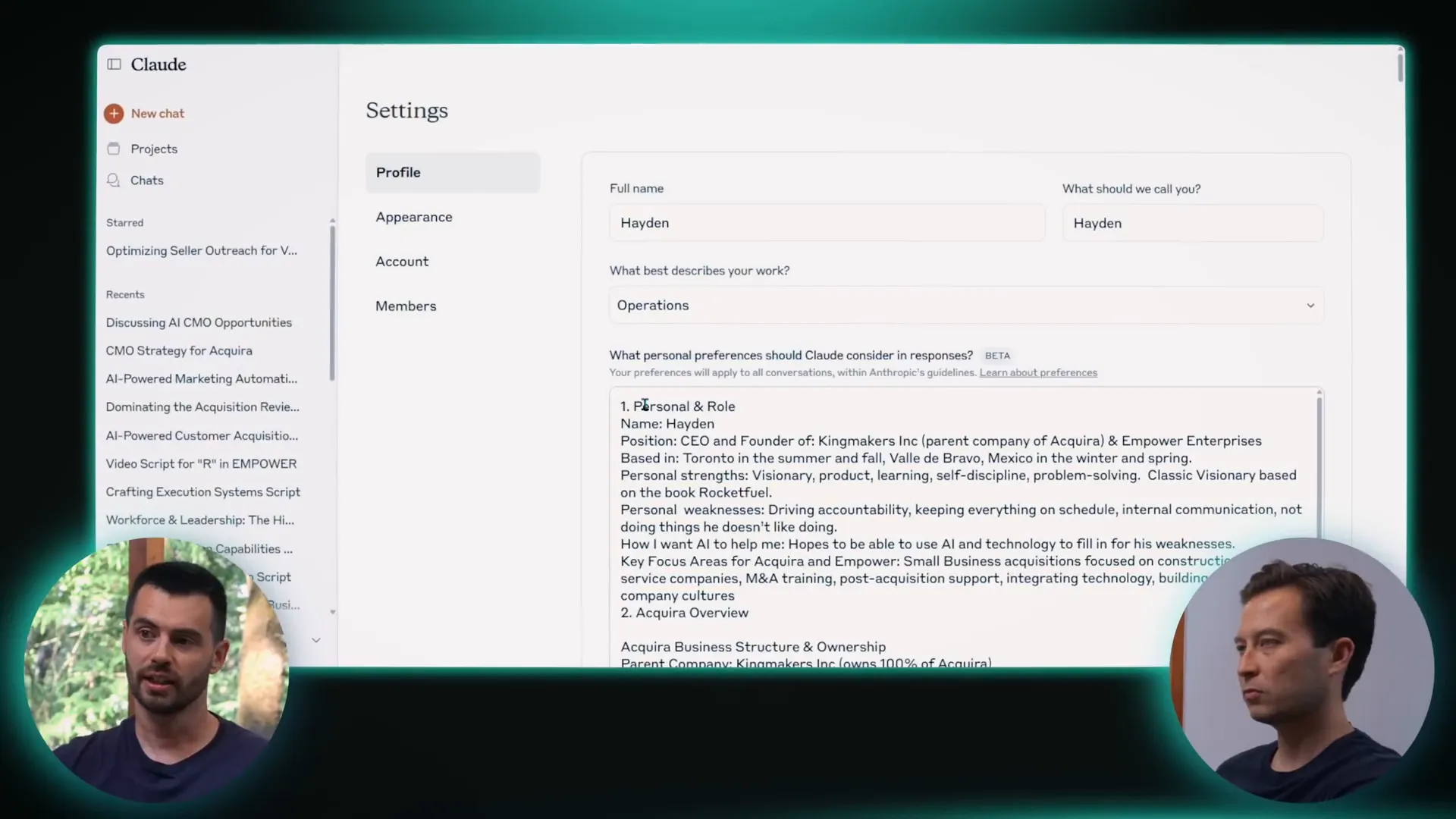
Real-world demo: AI in recruiting — how the Master Prompt transforms hiring
This is where the concept moves from theory to practice. If you want to understand the power of the Master Prompt, look at hiring. Hayden walks through a hiring workflow — hiring a Marketing Director for Acquire — and demonstrates how a master prompt changes the process from slow and opinion-driven to fast, repeatable, and measurable.
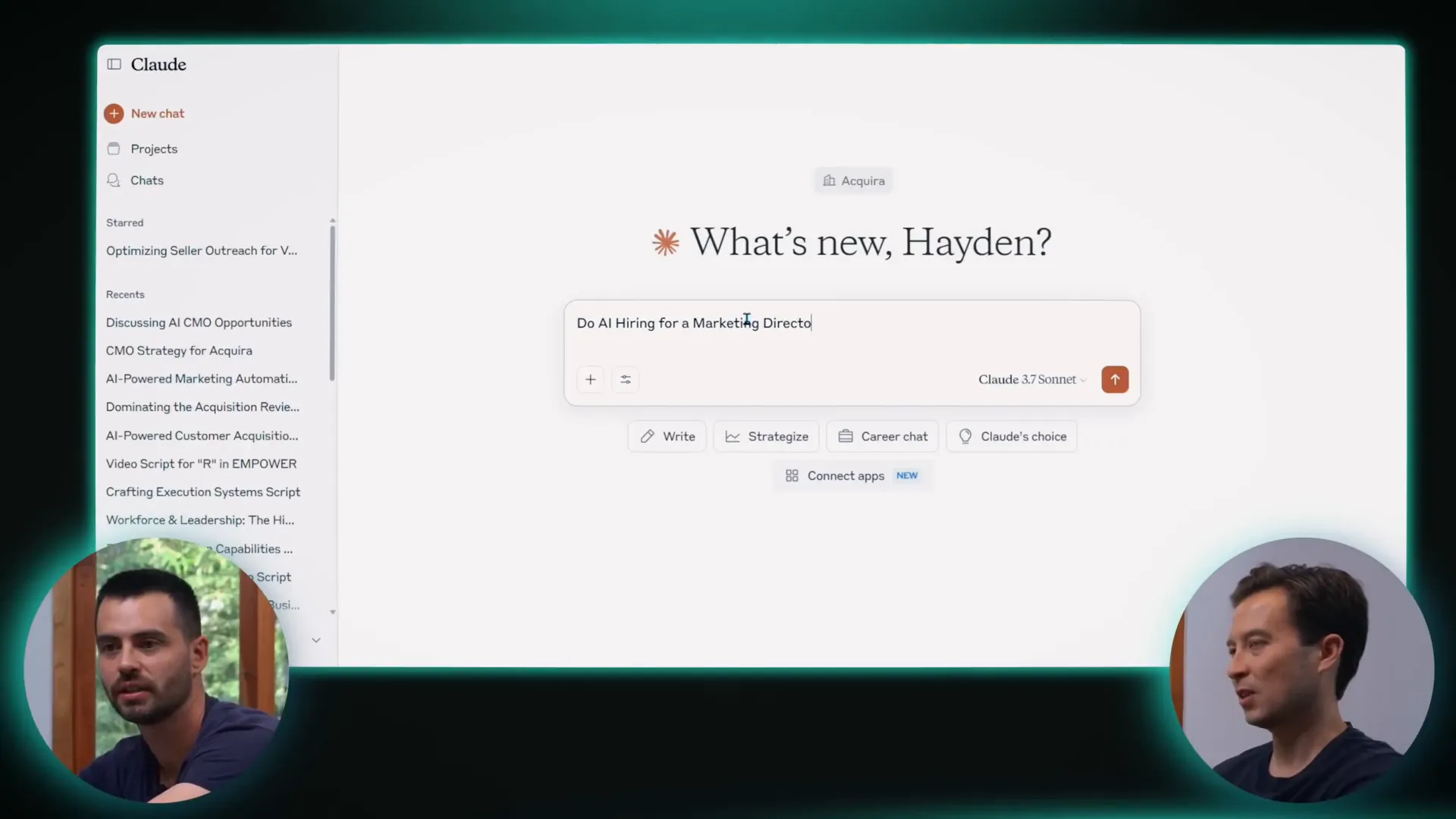
Before: the typical hiring mess
Consider how many small and mid-sized companies actually hire today. Usually it’s ad hoc: a hiring manager says "we need a marketing director," someone writes a quick job description, posts it, interviews a few candidates, and hopes for the best. There’s often no standardized interview structure, few measurable screening criteria, and no shared knowledge of what "success" looks like in month 1, month 3, or month 12.
Hayden points out the opportunity cost clearly: better hires compound. If a company can hire 50% more A-players using a repeatable process, growth diverges exponentially over time.
After: with the Master Prompt
Here’s what happens when you invoke a single protocol — "AI hiring" — inside a business-context-aware LLM:
- The model asks targeted questions about responsibilities and qualifications (if those details are ambiguous).
- It generates a detailed job description with measurable KPIs, quarterly targets, and "a-player vs b-player" performance markers.
- It creates recruitment artifacts: job postings, internal email drafts, screening checklists, sample interview questions, and practical work assignments for candidates.
- It scores and filters candidates by defined screening criteria (e.g., advance only candidates who score 20/30 or higher on a standard rubric).
What used to take a human team a week or more — including interviews, alignment meetings, and back-and-forth edits — can be created in under an hour. Most importantly, the output is consistent and aligned with company-specific metrics because the AI already "knows" your business via the master prompt.
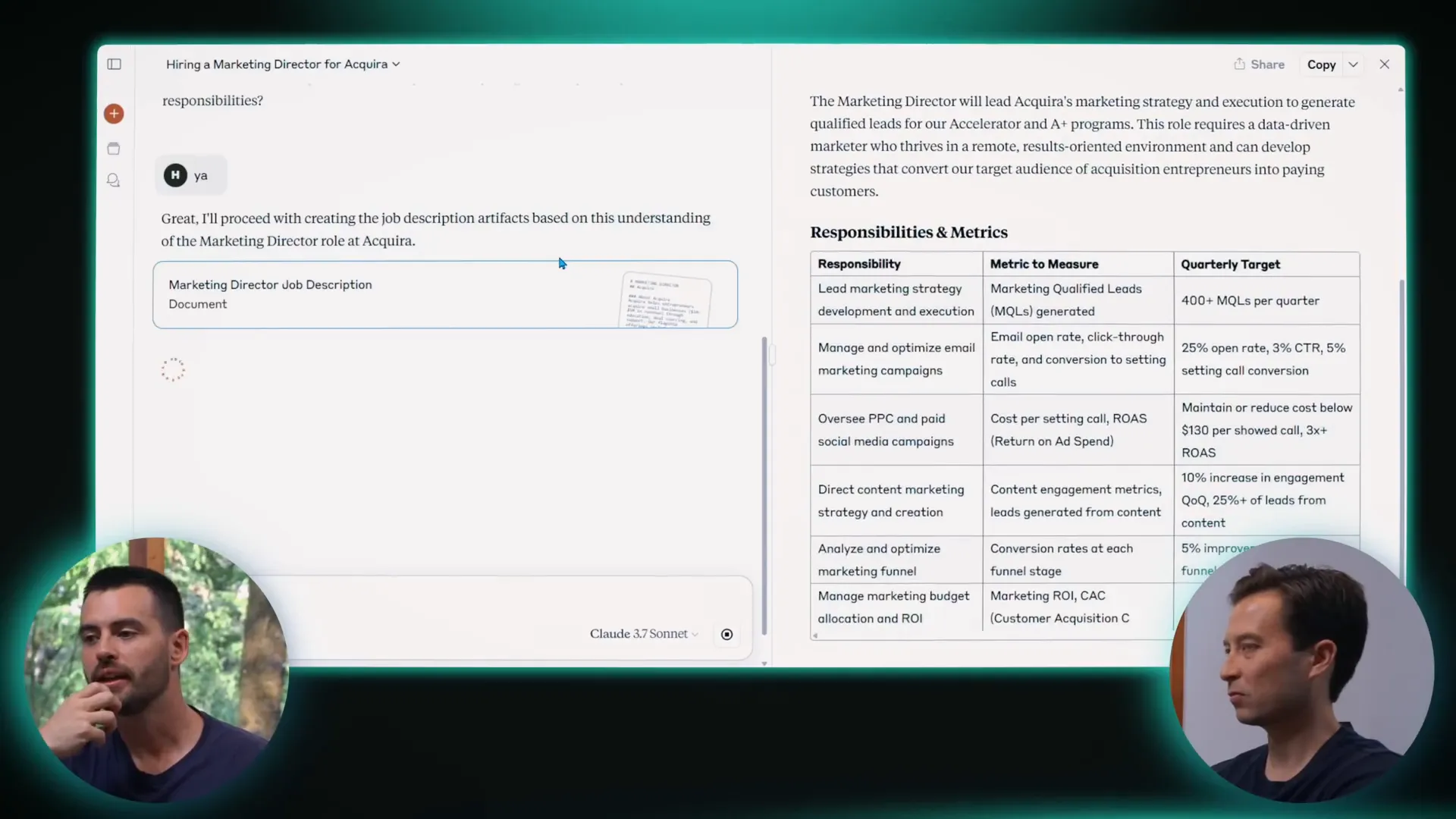
Putting the AI in recruiting: key benefits
Bringing AI in recruiting into your process yields concrete outcomes:
- Consistency: Every role has a repeatable, measurable hiring flow.
- Screening efficiency: You eliminate low-quality interviews and focus human time on top candidates.
- Higher hit-rate: More A-players per hire because the process is evidence-based and standardized.
- Speed: Faster time-to-hire without sacrificing quality.
Because hiring compounds, even small improvements in hiring conversion rates cascade into large differences in organizational capability and growth.
And again — the key to all of this is that the LLM uses your master prompt to produce hiring materials that are already tuned to your products, values, KPIs, and organizational structure. That’s what we mean by AI in recruiting: not a tool to write a job post, but an embedded system that executes your hiring playbook.
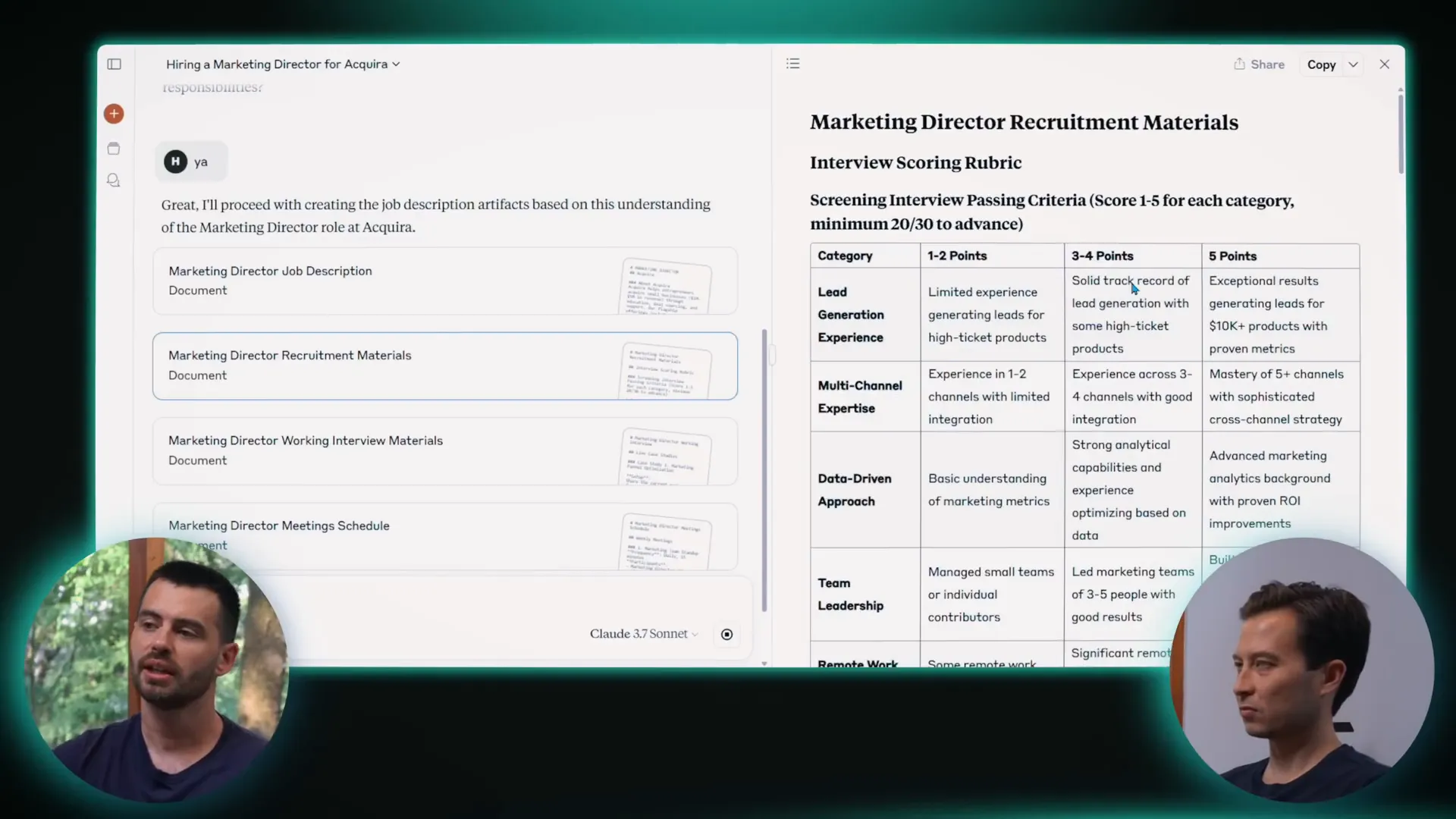
Real-world demo: AI SOPs and fulfillment engines
Hiring is one example. Another is operations: documentation, SOPs, and fulfillment engines. Hayden uses flowcharts that map customer journeys (e.g., from payment to LOI) and then asks the LLM to generate an SOP for every step. The model turned a complex, months-long documentation effort into something that required a fraction of the time to produce.
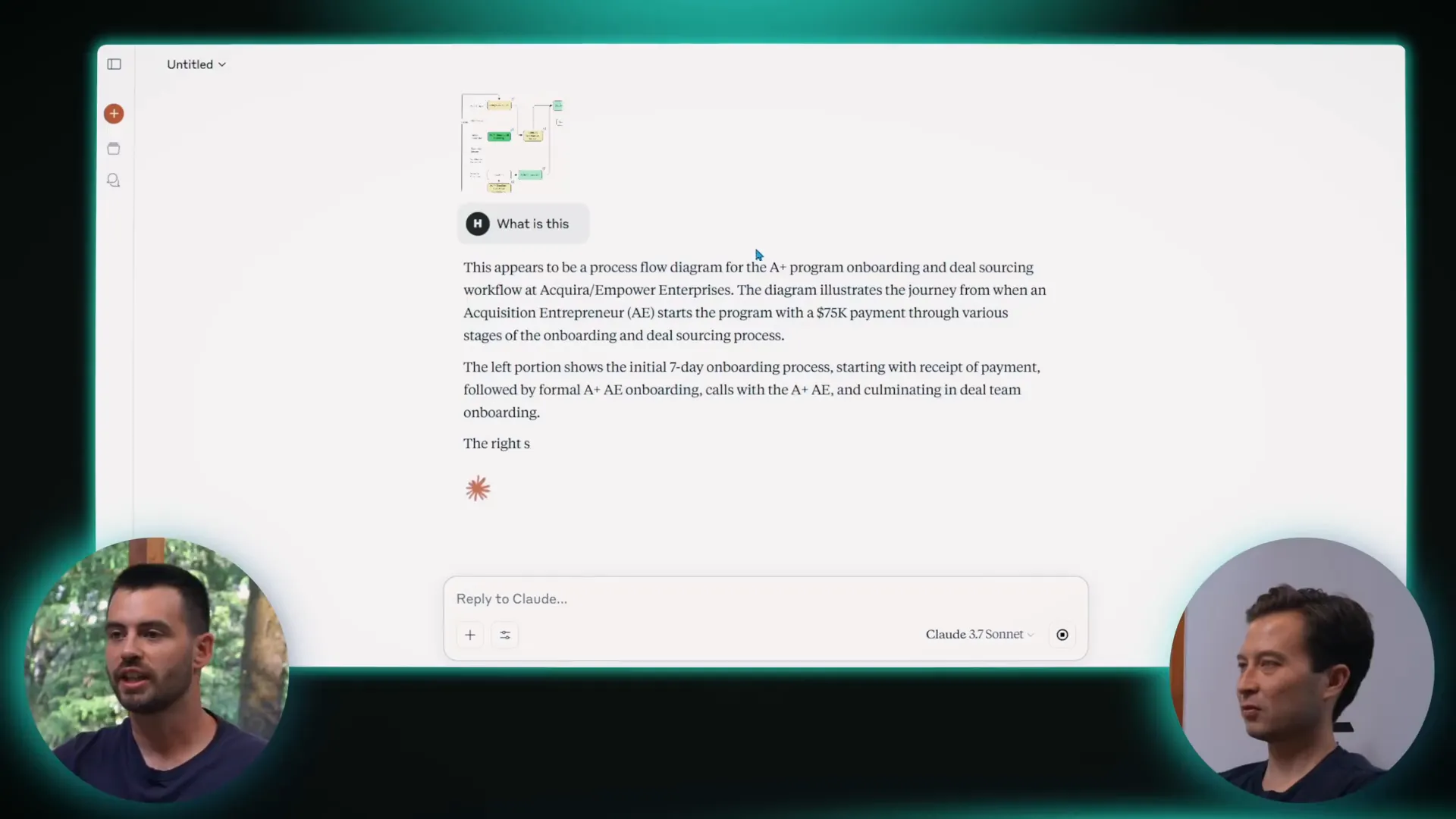
Why this matters for operations
Hayden emphasized three causes for operational failures and how SOPs fix the first two immediately:
- They didn't know it needed to be done.
- They didn't know how to do it.
- They weren't bought in to do it (this still requires leadership and change management).
Documented processes remove ambiguity: people know what must happen and how to do it. When the SOPs are accessible via a shared project in the LLM, employees can ask the AI clarifying questions and get responses rooted in your organization’s exact processes and culture.
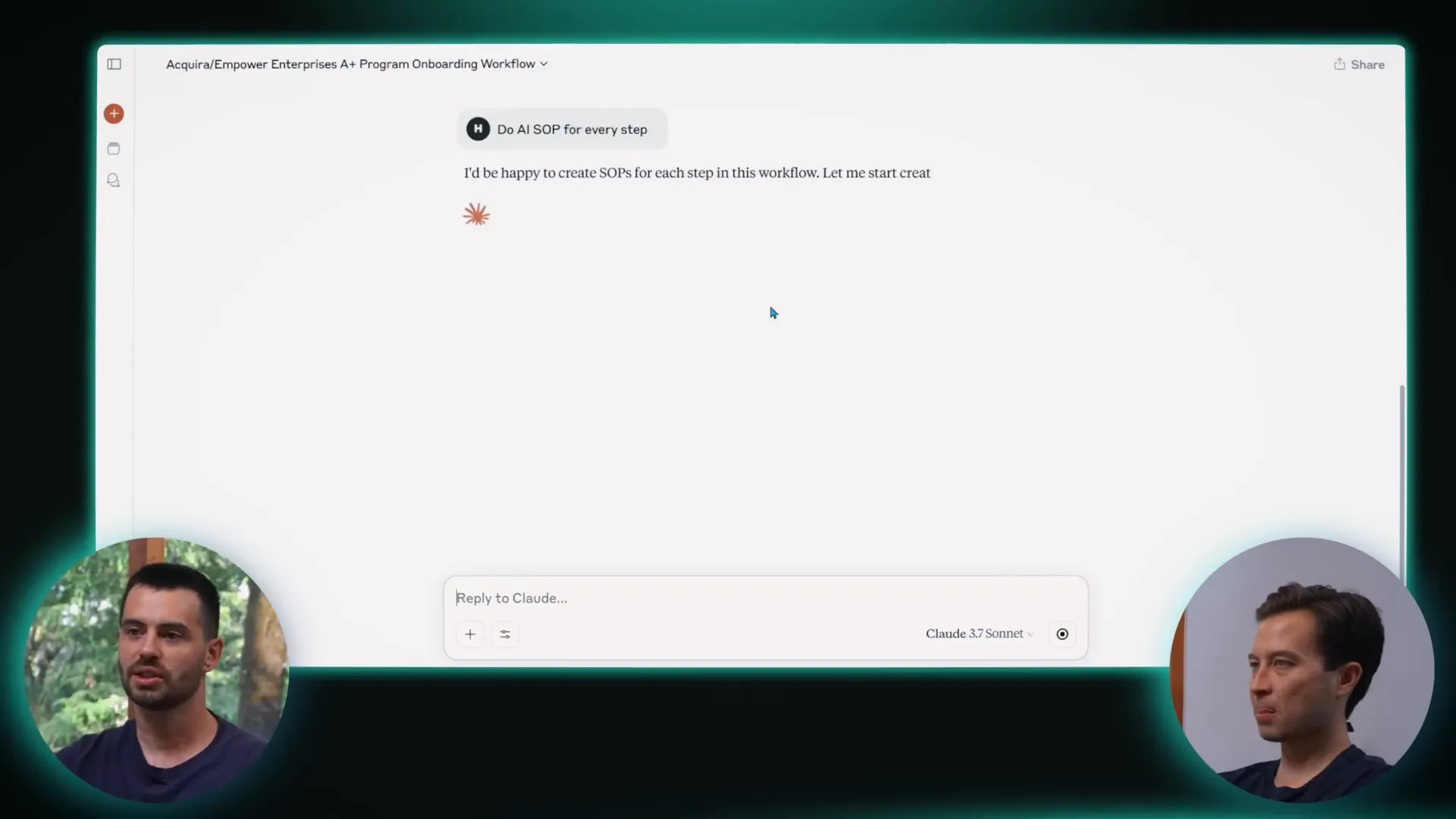
How the Master Prompt changes team structure and scaling
One of the more provocative parts of our discussion was how AI changes organizational layers. Hayden predicted the director layer might disappear and managers will oversee more front-line employees aided by AI. The logic is that AI will substitute much of the director-level synthesis and frameworks, leaving human managers to focus on coaching and frontline delivery.
This has two big implications:
- Companies can scale with fewer administrative overhead roles, allowing more of the payroll to go to revenue-generating frontline staff.
- The "valley of death" stage — where a company is too small to afford a full management layer and is trapped in inefficiency — becomes easier to traverse because small teams can achieve high-level execution with AI support.
Hayden also noted an important nuance: not all businesses will scale equally. Brick-and-mortar services (plumbing, HVAC) will still be constrained by human time, while digital and info businesses can scale far faster. For the latter, AI becomes a multiplier for revenue per employee in a way that radically changes unit economics.
How to build your v1 Master Prompt (step-by-step)
If you want to try this yourself, Hayden and I walked through a practical path to create a v1 master prompt using a simple Google Doc before moving into an LLM's preferences or project settings. Here’s the structure we recommend — a template you can start with today.
AI Agents For Recruiters, By Recruiters |
|
Supercharge Your Business |
| Learn More |
1. Personal info
- Your name and role.
- How you want AI to help you day-to-day.
- Your strengths and weaknesses (so AI can compensate).
Example: "Founder, strengths: product intuition; weaknesses: driving accountability and following up with internal comms." That way when you ask the AI for a project plan, it already knows to create accountability checkpoints.
2. Company info
- Legal name, founding date, employee count.
- Reporting structure (who reports to whom).
- Markets served and ideal customer profile.
Write one to two sentences for each item. If you don’t know a detail, use AI to draft it and then refine it.
3. What you do (value delivered)
Describe outcomes for your customers in one or two sentences. Focus on results, not features. This helps the AI write marketing copy, job descriptions, and onboarding narratives aligned with the value you deliver.
4. How you do it (differentiation)
Explain the processes, systems, and beliefs that differentiate you from competitors. If you have signature frameworks — like Hayden’s "one-three-one" decision protocol — include them as instructions the AI should follow whenever relevant.
5. Market and competitors
List your main competitors and what they do well. The AI will use this to position messaging, craft competitive responses, and suggest product improvements.
6. Team and KPIs
For each key role write the single most important KPI. Hayden recommended "one number" per person. That makes AI-generated performance targets and job descriptions measurable and comparable.
7. Products & pricing
Include every product or service, price points, features, and the intended customer benefits.
8. Culture and values
Define core values, mission, and BHAG. This is crucial: it keeps the AI’s outputs culturally aligned and prevents inconsistent tone or advice that contradicts your strategic identity.
9. Protocols and prompts
Create a list of trigger words (protocols) with short procedural definitions. Examples we used in the interview:
- AI hiring: Generate job descriptions, screening rubrics, interview scripts, and working interviews; produce recruitment artifacts and score candidates against defined criteria.
- AI SOP: Given a flowchart or step, create detailed SOPs, checklists, and escalation paths for each step.
- One-Three-One: Decision-making framework: determine the problem, desired outcome, three potential paths, one recommended path; ask five clarifying questions one at a time and await approval before continuing.
Once you have this document, you can paste it into Claude’s preferences or NotebookLM, or store it in a project that the LLM will reference automatically.
Practical tips and iteration
Hayden gave several advice points that are worth repeating:
- Start small. A paragraph for each section is fine. Anything is better than nothing.
- Iterate inside the model. Use the AI to help you draft and refine the master prompt itself.
- Answer the AI’s clarifying questions when prompted and let it draft artifacts for you.
- Watch for gaps. If the AI misunderstands something, update the master prompt to correct it and avoid repeating that gap.
- Keep your goals flexible. As you experiment with AI, your strategy and KPIs will likely change — plan for that.
One particularly useful coaching trick Hayden uses with Claude is to have the model ask questions and then answer them itself based on the master prompt, pausing for his approval before proceeding. That saves time and surfaces misunderstandings early.
How to apply this to AI in recruiting (summary checklist)
If your top interest is AI in recruiting, here’s a short action checklist to implement the Master Prompt Method today:
- Create a "Recruiting" project in your LLM and paste the relevant hiring sections of your master prompt there.
- Define the "AI hiring" protocol with screening criteria and the scoring rubric (e.g., cover letter must cover X, Y, Z; advance only if score ≥ 20/30).
- Include role-specific KPIs and month 1/3/12 success metrics in the candidate rubric.
- Ask the model to generate job posts, screening questions, email templates, and working interview assignments.
- Use the LLM to pre-screen by scoring resumes and cover letters against your rubric.
- Use AI-generated interview guides and homework to standardize interviews and compare candidates objectively.
- Iterate your master prompt based on outcomes (which hires succeed and which don’t) to improve selection over time.
Repeat this system for every role and you’ll quickly see how AI in recruiting stops being a novelty and becomes the backbone of repeatable hiring that scales.
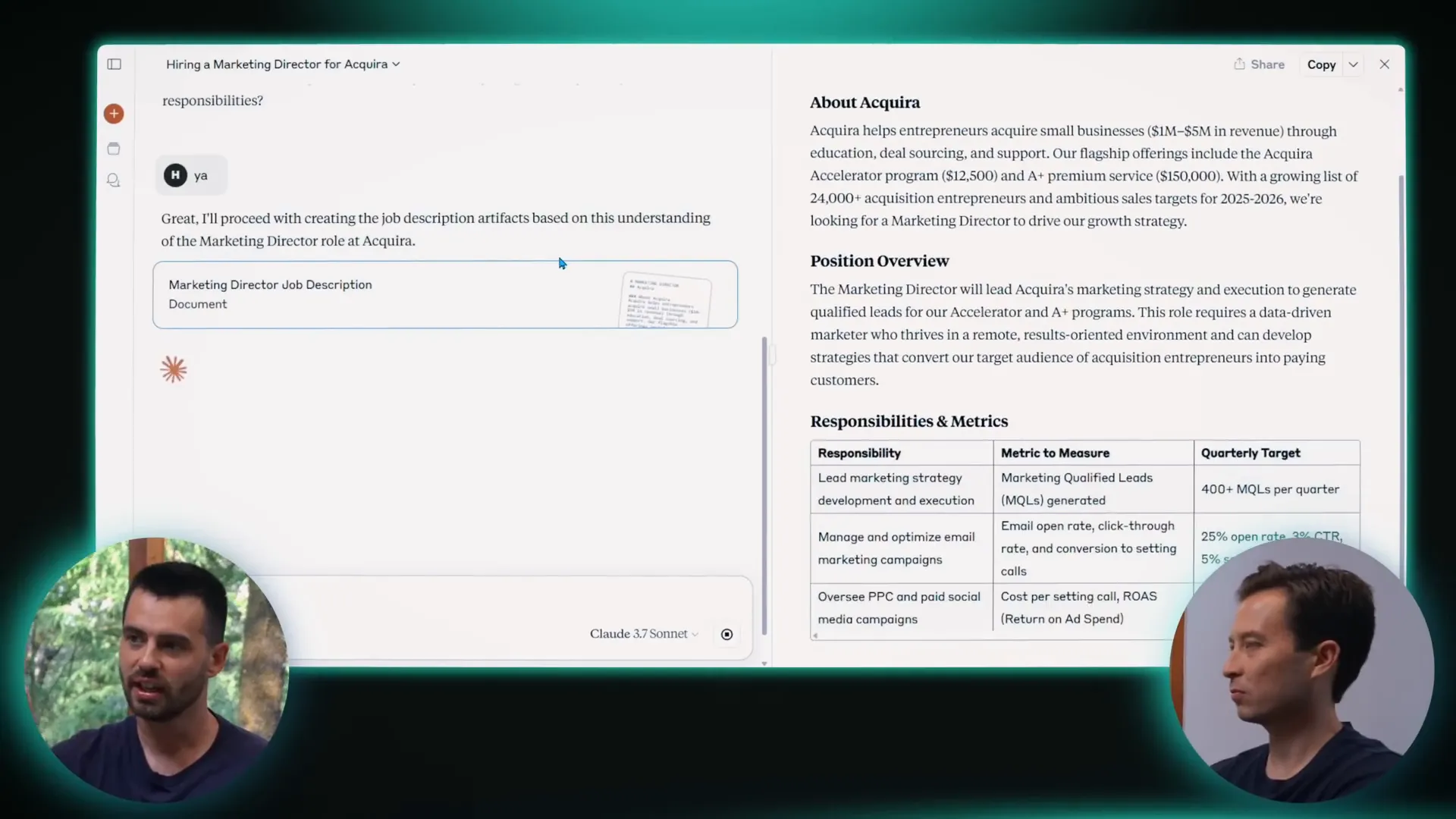
Common objections and pitfalls
Two common concerns came up during the conversation:
1) "AI can’t take calls or run the field."
Hayden is explicit about the limits. AI replaces cognitive labor — writing, planning, screening, process documentation — but it doesn’t yet replace human labor in the field (e.g., plumbers, technicians). For many service businesses, AI multiplies the effectiveness of managers and improves scheduling and process, but you still need human capacity for on-site work.
2) "People will resist change and not buy in."
Documenting SOPs with AI can actually create a buy-in problem: humans who spent months crafting processes may feel sidelined. Hayden’s solution is to involve team members in iteration, and to treat the Master Prompt as a living document that people update. Use clarity boards and share projects so employees can see how AI supports their work rather than replaces their contribution.
Final thoughts: Start now, iterate fast
The Master Prompt Method is deceptively simple: it asks you to capture the single truth of your business in a persistent document and attach a set of protocols that the AI can run. But the outcomes — faster execution, higher-quality output, better hires, clearer SOPs — compound over time.
For those focused on AI in recruiting, the lesson is immediate: standardize your hiring playbook, encode it in your master prompt, and let the AI do the heavy lifting of screening, scoring, and artifact creation. The result is higher conversion rates on hires and faster, more consistent recruiting cycles.
If you try building a v1 master prompt, please iterate publicly: record what worked, what didn’t, and how the AI impacted your hiring metrics. The learning accelerates when we share practical examples.
Resources and next steps
To get started today:
- Create a Google Doc and populate the sections we outlined: personal info, company info, what/ how/ who, team KPIs, products, culture, and protocols.
- Decide where to store it: Claude preferences, NotebookLM, or another platform that supports shared project knowledge.
- Pick one protocol to implement first. For most organizations that’s "AI hiring" or "AI SOP."
- Iterate weekly: update the master prompt based on what the AI gets wrong and what it gets right.
AI in recruiting is not a plug-and-play fad — it’s a structural shift in how you think about talent acquisition. But with a Master Prompt, you can start today and build an unfair advantage that compounds.
If you’d like a concrete starter template, I recommend building the nine sections above into a single Google Doc and using the prompts we discussed (One-Three-One, AI hiring, AI SOP) as your initial protocols. Then push that document into your LLM of choice and begin testing.